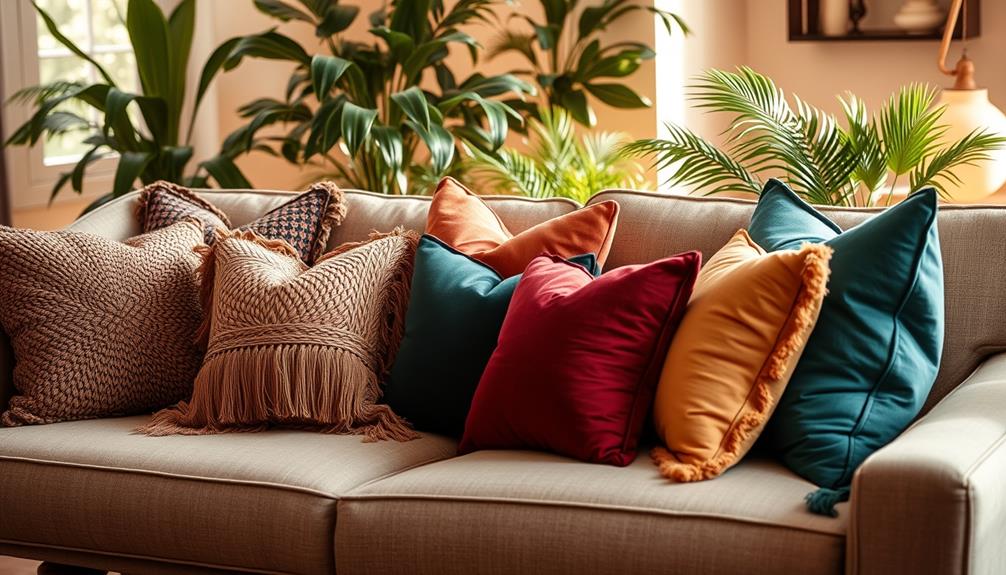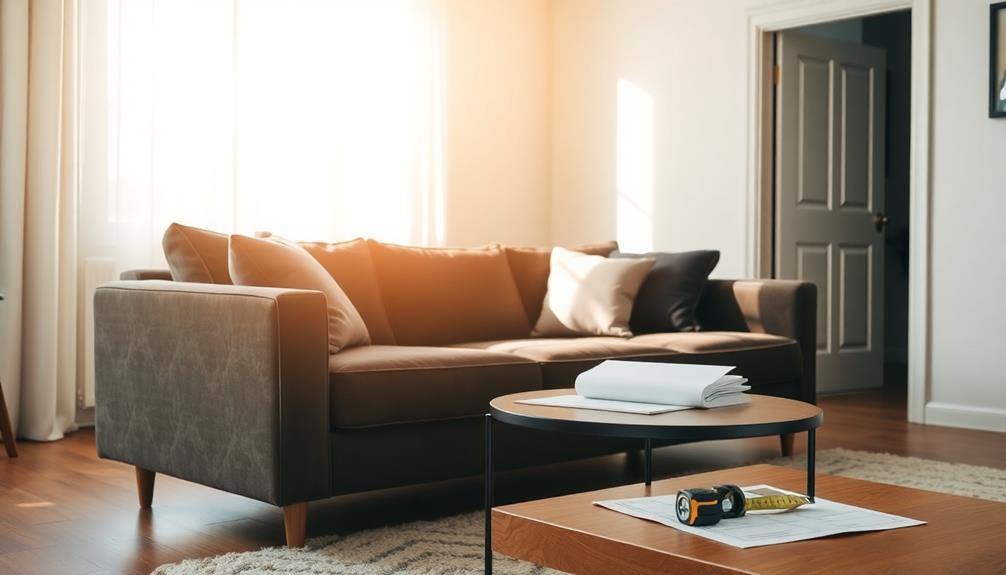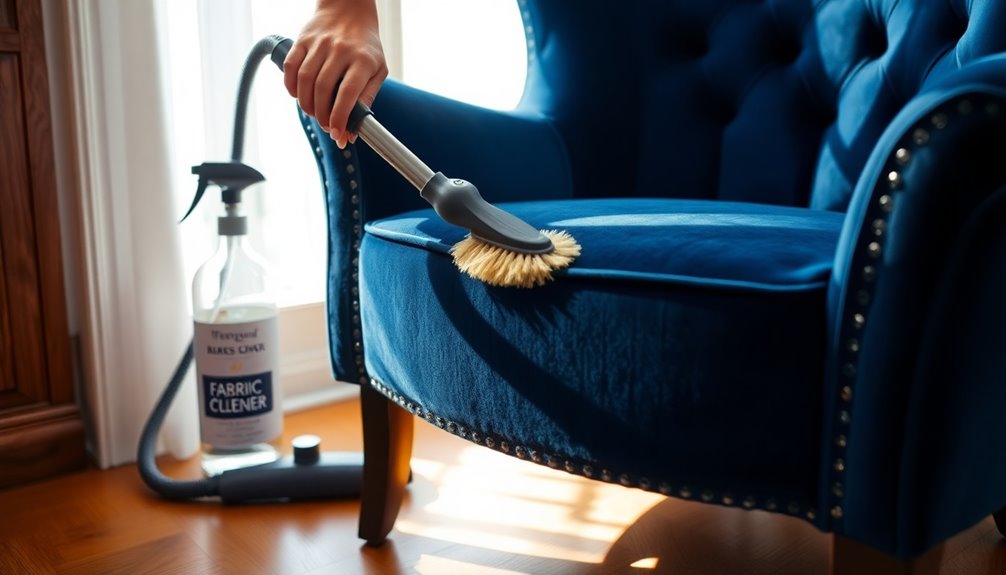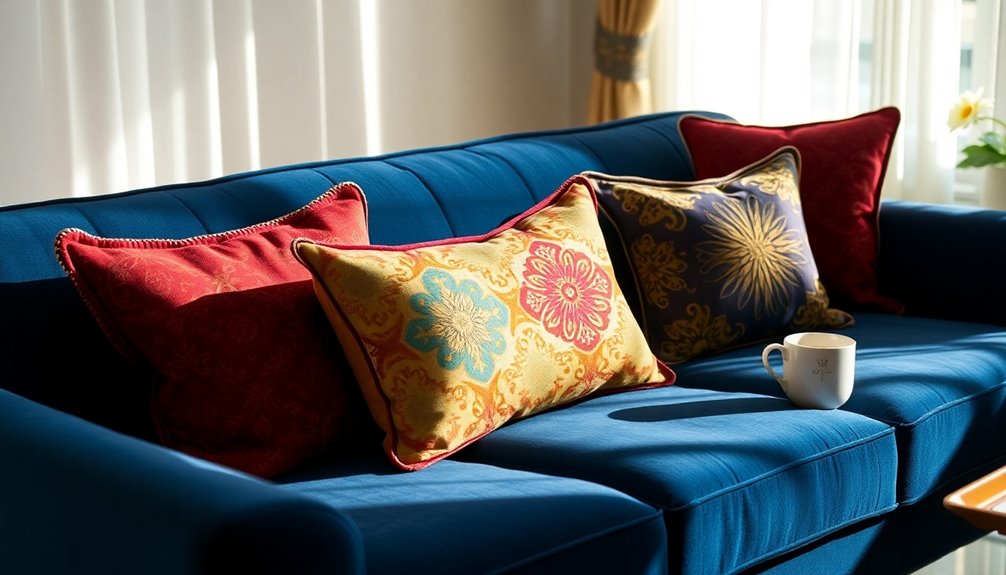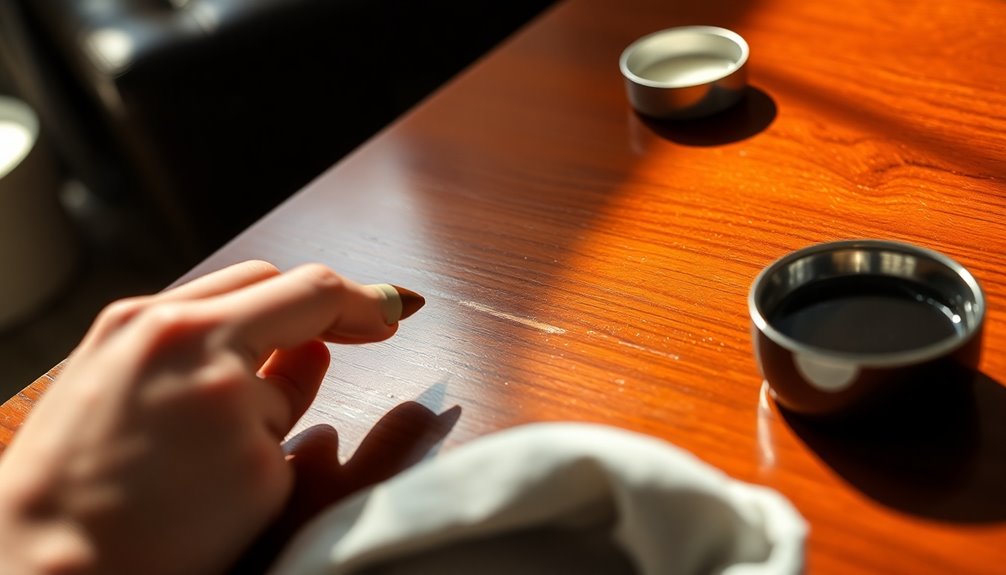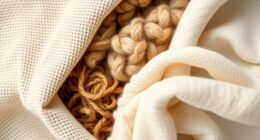When selecting decorative pillows for your couch, start by taking into account the size – 20-inch squares are suitable for standard sofas, while loveseats may only require 1 to 3 larger pillows. Choose 3 to 5 colors that complement your current decor, incorporating patterns that share a main hue for a cohesive look. Incorporate a variety of textures, such as velvet and linen, for added depth. When organizing the pillows, go for odd numbers to achieve a balanced appearance and experiment with different shapes to add visual interest. For additional creative ideas and styling advice, explore even more inspiration that may be waiting for you here.
Key Takeaways
- Select pillow sizes based on your sofa type: 20-inch for standard, 16-18 inch for modern low-back, and larger pillows for deeper couches.
- Choose 3 to 5 colors from an anchor color in your decor for a cohesive color palette among the pillows.
- Mix patterns by combining a solid, a simple print, and a busy print, ensuring they share a common color to maintain harmony.
- Arrange pillows in odd numbers (3, 5, or 7) for a visually balanced and dynamic look on your sofa.
- Incorporate different textures, such as velvet and linen, to add depth and interest to your pillow arrangement.
Selecting the Right Size
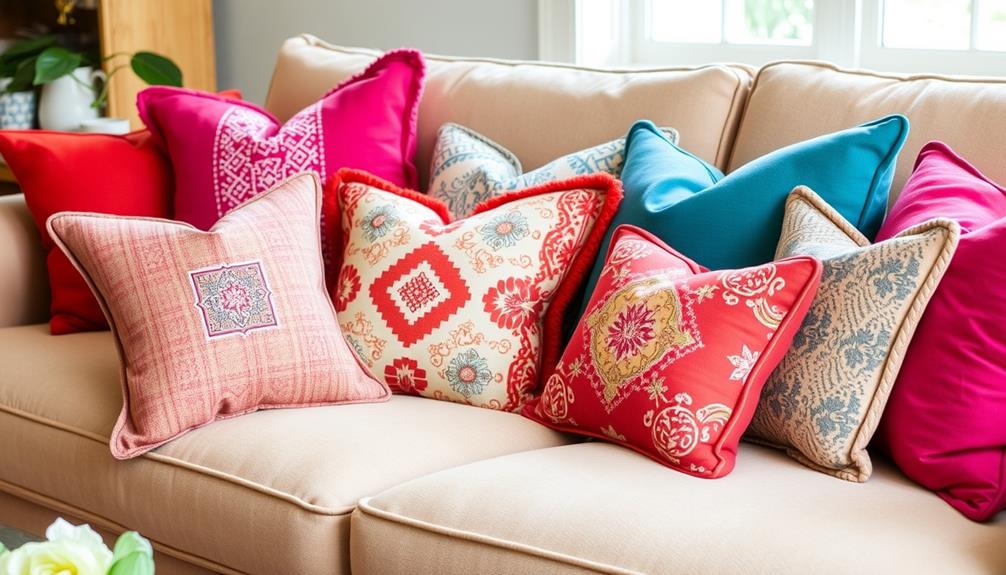
When it comes to your sofa's aesthetic, selecting the right size of throw pillows is crucial. Start by considering pillow sizes that fit your sofa's dimensions. For standard sofas, 20-inch square pillows are a great choice, while modern low-back couches may look best with 16-inch or 18-inch pillows.
To enhance the overall design, remember that your personal influences can shape the selection of colors and patterns, adding to the unique charm of your space. You'll want to aim for five pillows on a 6-foot sofa, adjusting to five to seven for larger sofas, and consider three for loveseats to maintain an aesthetically pleasing odd number.
To create a balanced look, arrange pillows by size. Place the largest pillow on the outside and smaller pillows in the center. This arrangement not only enhances visual interest but also guarantees your pillows complement the couch without overwhelming it.
For sectionals, use larger pillows for back support and smaller pillows as decorative accents, adjusting sizes based on your configuration and personal style. By utilizing mood boards to visualize your pillow choices, you can better coordinate with your overall interior design concept.
Ideal Pillow Quantities

Finding the ideal number of throw pillows for your sofa can transform your living space's comfort and aesthetics. Generally, you'll want to follow these guidelines based on the type of seating you have:
| Sofa Type | Recommended Pillow Quantities | Notes |
|---|---|---|
| Standard Sofa | 3 to 6 pillows | Odd numbers create visual harmony. |
| Loveseat | 1 to 3 pillows | Larger pillows for a relaxed look. |
| Sectional Sofa | Up to 7 pillows | Guarantee comfort and maintain balance. |
| Deeper Couches | Larger pillows | Provide adequate back support. |
| Shallower Couches | Smaller pillows | Effective for comfort and style. |
Using three pillows or other odd numbers like five or seven helps create a more visually appealing arrangement. You can mix pillows in different sizes to enhance comfort and style. Avoid using an even number of pillows on a couch, as it can appear unbalanced or overly formal. By considering these pillow quantities and arrangements, you'll achieve a cozy, inviting space that feels just right.
Color Coordination Strategies
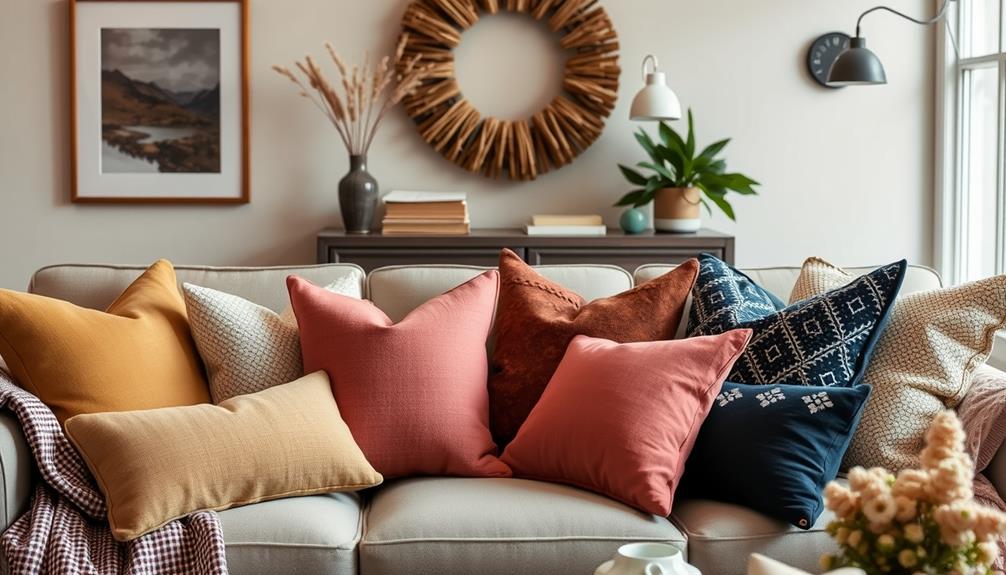
When choosing throw pillows, start by picking an anchor color from your existing furniture to create a cohesive look.
Consider incorporating natural materials like linen or cotton to align with the modern farmhouse decor trends of 2024, which emphasize comfort and sustainability.
Use the color wheel to find complementary patterns that enhance your space. This way, you can mix in bold designs while ensuring everything coordinates beautifully, adding texture reminiscent of essential elements for farmhouse bedroom design.
Anchor Color Selection
To create a cohesive look for your sofa, selecting an anchor color from your existing decor is essential. This anchor color will set the tone for your throw pillows, ensuring they complement your room's overall aesthetic.
Aim to use 3-5 colors derived from your anchor color to craft a harmonious color palette. This approach balances visual interest and unity in design. Incorporating textures and patterns that reflect your anchor color can also enhance the overall design, as seen in the way tableware misconceptions often blend various elements for aesthetic appeal.
Utilizing a color wheel can help you identify complementary shades that enhance your anchor color. For example, if your anchor color is a deep blue, consider incorporating soft yellows or warm oranges for contrast.
If you prefer an eclectic style, incorporate bold patterns that feature your anchor color. On the other hand, minimalist styles benefit from solid pillows to maintain simplicity.
Make sure that all pillow prints share a dominant color from your anchor choice. This will allow for a diverse yet coordinated appearance across different patterns and textures.
Complementary Patterns Usage
Choosing the right patterns for your throw pillows can elevate your sofa's style and create visual harmony within your space. To achieve this, focus on patterns that share a dominant color with the color of the sofa or other elements in the room. This strategy guarantees a cohesive look throughout your decor, much like selecting high-protein breakfast options that complement a healthy lifestyle.
Utilizing a color wheel can help you identify complementary shades that enhance your existing color scheme. Aim to mix and match throw pillows using three different patterns for added visual appeal:
- One solid color for a grounded base
- One simple print to maintain balance
- One busy print to inject energy and interest
It's essential that these different patterns maintain a common color bond, unifying the designs and preventing visual clutter.
Incorporating geometric patterns can introduce a modern touch, while floral designs may add a vibrant feel, depending on your room's overall aesthetic.
Pattern Mixing Techniques

When mixing patterns, you'll want to balance bold designs with subtle ones to create a visually appealing arrangement.
Incorporating tips from creative ideas to transform your space can elevate your pillow selection.
Using complementary color schemes can help tie everything together, making your pillows look cohesive.
Balance Bold and Subtle
While mixing patterns can seem challenging, striking a balance between bold and subtle designs is key to achieving a visually appealing pillow arrangement. To create harmony, select three patterns that share colors from your chosen palette. This guarantees cohesion while allowing for variety. Incorporating elements like color coordination can enhance your overall aesthetic.
Consider these tips for an effective mix:
- Combine bold and subtle: Use a large geometric print alongside solid colors or smaller floral patterns to create contrast.
- Vary textures: Incorporate materials like velvet, linen, and cotton to add depth to your arrangement.
- Stick to an odd number: Grouping your pillows in odd numbers (3, 5, or 7) results in a modern aesthetic that feels dynamic.
Using the rule of three can also help maintain balance. Incorporate one simple print, one busy print, and one solid pillow to achieve a well-rounded look without overwhelming your space.
Use Complementary Color Schemes
To elevate your throw pillow arrangement, consider using complementary color schemes that create striking contrasts and visual interest. Start by selecting an anchor color that reflects your room's existing color palette. This foundation will help create a cohesive look.
Use the color wheel to identify complementary shades; for example, pairing blue throw pillows with orange accents can lead to a vibrant and eye-catching contrast. Additionally, you can draw inspiration from celebrity lifestyle insights, such as how art and interiors reveal collectible decor trends among celebrities, to find unique combinations for your space.
Mixing three different patterns is key to maintaining harmony while adding visual interest. Combine a floral, geometric, and striped pattern in similar hues to create a dynamic arrangement.
Additionally, don't forget to incorporate varying textures like velvet, linen, and faux fur. These tactile elements enhance the appeal of your pillow arrangement without disrupting your color palette.
For a more dynamic look, aim for odd numbers of pillows, such as three or five. This approach not only provides a balanced mix of colors and patterns but also adds a visually pleasing aspect to your sofa.
Adding Texture Variations

Throw pillows can transform your sofa into a cozy haven, and adding texture variations is key to achieving that inviting look. By incorporating a mix of fabrics like velvet, linen, faux fur, and chunky knits, you can greatly enhance the visual interest of your arrangement.
Consider adding DIY Fire Pit Ideas for a well-rounded outdoor living space that complements your indoor decor. Aim for at least three different textures to create depth and complexity, ensuring no single texture overwhelms the space.
Consider these tips when selecting your pillows:
- Mix smooth and textured fabrics: This creates a dynamic contrast that draws the eye and encourages tactile engagement.
- Balance solid and patterned pillows: This prevents the arrangement from feeling chaotic and allows each texture to complement the others.
- Think seasonally: Use heavier fabrics like velvet for winter and lighter options such as linen for warmer months.
With a thoughtful approach to texture, your pillow selection won't only elevate your sofa's aesthetics but also make it a more inviting space to relax in.
Keep experimenting until you find the perfect blend of colors and textures that resonate with your style!
Shape and Form Considerations

Variety in shape and form plays an essential role in elevating your sofa's aesthetic. When considering shape and form, think about incorporating square throw pillows, lumbar pillows, and even rounded options. Standard square pillows (20-22 inches) provide a classic look, while lumbar pillows (14×22 inches) add ergonomic support and a modern touch. Mixing and matching these shapes creates visual interest and breaks up monotony in your sofa styling.
Additionally, using pillows with different textures, such as velvet or linen, can create a more dynamic visual appeal that complements your decor style. Consider also incorporating pillows in colors that reflect the vibrant hues found in your home, such as the health benefits of juices which can inspire a lively color palette.
Don't shy away from experimenting with different sizes. Using larger pillows as anchors at the back and smaller ones in front helps establish a layering effect, making your seating area feel more inviting. Pairing oversized pillows with smaller accent pieces not only enhances the overall aesthetic but also adds depth and movement to your decor.
Consider the arrangement of your pillows; a dynamic mix of shapes and sizes will elevate your space and make it feel personalized. By focusing on these shape and form considerations, you can create a comfortable and visually appealing environment that reflects your style. Embrace the creative possibilities, and let your sofa become a statement piece in your home.
Seasonal Styling Ideas

When it comes to seasonal styling, think about how color palettes and textures can transform your sofa.
For instance, warm tones and chunky knits create a cozy fall vibe, while vibrant florals and light fabrics bring spring to life.
Incorporating elements of coffee culture can also inspire your pillow choices, providing a unique touch that reflects your love for coffee.
Seasonal Color Palettes
Transforming your sofa with seasonal color palettes can instantly refresh your living space and reflect the changing moods of the year.
By strategically selecting throw pillows in vibrant colors, you can set the tone for each season while enhancing your living room decor.
Here are some ideas for seasonal palettes:
- Fall: Embrace warm colors like burnt orange, deep reds, and mustard yellows. Add different textures, such as chunky knits or faux fur, to create a cozy vibe.
- Winter: Opt for rich jewel tones like emerald green and sapphire blue. Use heavier fabrics like velvet to make your space feel inviting during the colder months.
- Spring: Choose light, airy colors like pastel pinks and soft greens. Incorporate floral patterns and lightweight fabrics like linen to reflect the season's freshness.
Textures for Seasonal Appeal
Choosing the right textures for your throw pillows can elevate your seasonal decor even further. For fall, incorporate warm textures like chunky knits and faux fur to create a cozy atmosphere that resonates with the season's aesthetic. These elements invite comfort as the weather cools down.
In spring, switch to lighter fabrics such as linen and cotton adorned with floral patterns. This evokes freshness and a sense of renewal in your living space, perfect for the blossoming season.
For summer, consider nautical prints and breathable materials like canvas to reflect a breezy, seaside vibe that complements warm weather. These textures bring a light, airy feel to your decor.
When winter arrives, opt for heavier fabrics like velvet and thicker knits. They not only provide warmth and comfort but also enhance the cozy ambiance of your home during the cold months.
Don't forget about mixing textures! Combining smooth silk with plush velvet adds depth and visual interest while adapting to seasonal changes.
Professional Design Assistance
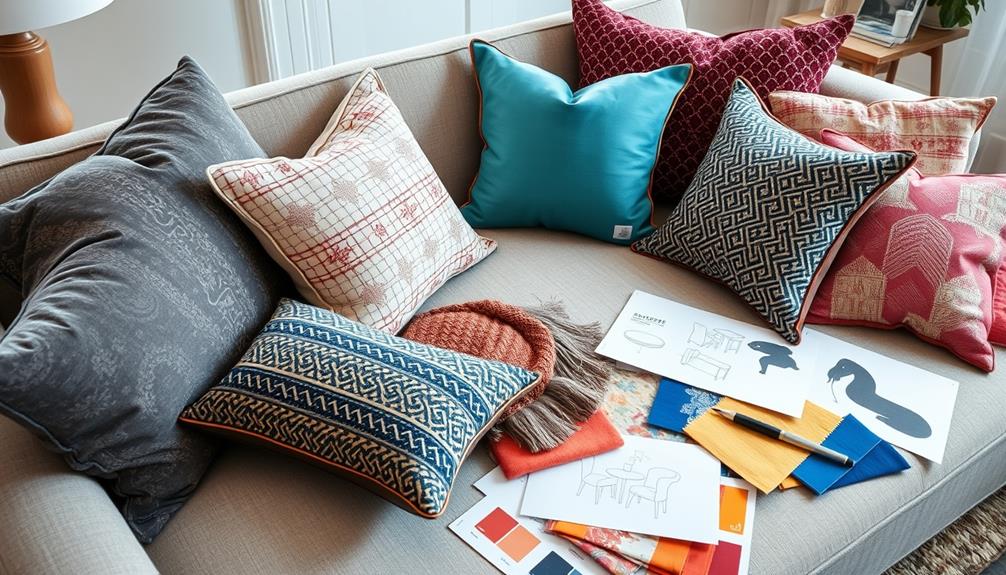
Seeking professional design assistance can elevate your sofa's aesthetic and comfort level considerably. By working with professional designers, you gain access to personalized pillow advice tailored specifically to your sofa's dimensions and existing decor. They help you coordinate colors and patterns, ensuring a cohesive look that enhances your living space.
Here are three benefits of engaging with design services:
- Customized Recommendations: Designers provide insights on the ideal number of pillows based on your sofa's dimensions and usage, ensuring both aesthetics and comfort are maintained.
- Variety of Options: You'll have access to an array of fabric swatches, enabling you to visualize how different materials will complement your sofa and overall decor.
- Streamlined Selection Process: Professional assistance can save you time, making the selection process more efficient and resulting in a polished, stylish arrangement in your home.
Creative Grouping Methods

Grouping throw pillows creatively can greatly enhance your sofa's visual appeal. Start by arranging your throw pillows in odd numbers, like three or five; this creates a more dynamic and engaging look.
Utilize different sizes by placing larger pillows at the back and smaller ones in front. This not only guarantees a layered look but also adds depth to your sofa. To further enhance the visual appeal, consider mixing textures and patterns for a more dynamic arrangement. Don’t forget about functionality; knowing how to fluff sofa cushions properly can also keep them looking fresh and comfortable. Regularly shaking out and adjusting the cushions will help maintain their shape and ensure that your sofa remains inviting for guests.
Mixing shapes is essential for visual interest, so incorporate square, rectangular, and round pillows. This variety helps prevent monotony and enhances the overall aesthetic.
Don't forget about textures! Combine materials like velvet, linen, and faux fur within your group pillows to add richness and tactile appeal.
Lastly, consider seasonal themes when grouping your throw pillows. For example, opt for warm colors and heavier fabrics in fall, while choosing light florals in spring.
This allows you to refresh your sofa's look throughout the year, keeping it stylish and inviting. By thoughtfully selecting and arranging your throw pillows, you can effortlessly create a cozy and appealing space that reflects your personal style.
Resources for Inspiration

Finding inspiration for your throw pillow choices can greatly elevate your sofa's aesthetic. Start by exploring color wheels and online design blogs to help you select cohesive color palettes and complementary patterns. This will guarantee your throw pillows not only look good but also harmonize with your overall decor.
Consider tapping into community-shared inspirations on social media. Platforms like Instagram and Pinterest are treasure troves of creative pillow arrangements. Check out hashtags like #BallardDesigns to find unique style pillows that reflect your personality.
Here are some resources to ignite your creativity:
- Seasonal Decor Ideas: Refresh your pillow selection with warm colors for fall or nautical prints for summer.
- Professional Guidance: Engage in complimentary styling appointments for personalized pillow selection advice.
- Home Decor Brands: Sign up for newsletters to receive ongoing tips, trends, and exclusive promotions that can inform your throw pillow choices.
Frequently Asked Questions
How Many Throw Pillows Should There Be on a Sofa?
You should aim for five to seven throw pillows on a standard sofa for balance. Odd numbers look better, but don't hesitate to mix it up based on your style and the sofa's depth.
Should Couch Throw Pillows Match?
Oh sure, let's just throw a matching pillow parade! But really, you don't need to match couch throw pillows. Mix colors, patterns, and textures for a unique look that reflects your style and creativity.
What Is the 2 2 1 Pillow Rule?
The 2-2-1 pillow rule suggests you arrange two large pillows on each end, two medium ones in the center, and one small lumbar pillow, creating balance and enhancing your sofa's comfort and visual appeal.
How Do You Pick Out Throw Pillows?
Pillow picking's a playful pursuit! Start by sizing up your sofa, selecting stylish shades, and mixing marvelous materials. Remember to arrange an odd number of pillows for a pleasingly polished presentation that's perfectly inviting.
Conclusion
Choosing the right throw pillows can transform your sofa from ordinary to extraordinary. By considering size, color, and texture, you can create a cohesive look that reflects your style. Don't forget to mix patterns and experiment with groupings for added interest! So, why not take a moment to refresh your space and elevate your comfort? With a few thoughtful choices, you'll find the perfect pillows that make your sofa a true focal point in your home. Additionally, consider the function of your throw pillows beyond just adding style. Look for pillows with the right amount of support for increasing sofa sleep comfort. Finding the perfect balance of aesthetics and functionality will ensure that your sofa is not only beautiful, but also inviting and comfortable for lounging or napping. With the right throw pillows, you can truly make your sofa a versatile and welcoming centerpiece in your living space. If you want to take your sofa to the next level, consider getting a dream minecraft sofa that not only looks great but also feels amazing to sit on. You can find the perfect combination of style and comfort by selecting pillows that complement the design of your sofa and add a touch of personality to the room. By investing in quality throw pillows, you can create a space that is both stylish and functional, making your sofa the perfect place to relax and unwind after a long day.
